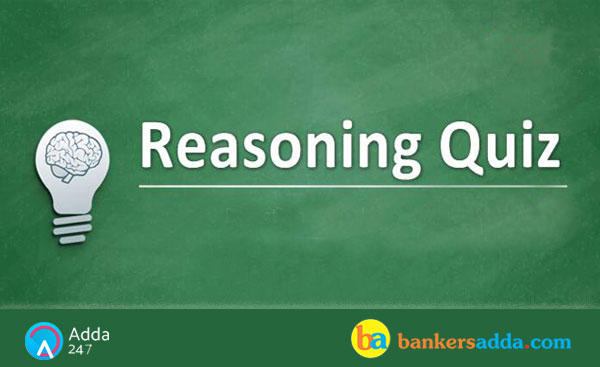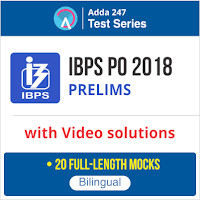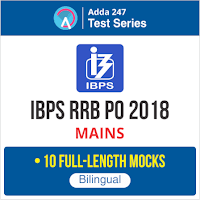
Directions (1-5): In each of the questions below consists of a question and two statements numbered I and II given below it. You have to decide whether the data provided in the statements are sufficient to answer the question. Read both the statements and Give answer-
Q1. How is 'Name' coded in the code language?
Statements:
I. 'Jolly Kotak Norway’ means ‘@ # &' and 'Name Kotak Just’ means ‘$ * #'.
II. 'Name Youth Sometime' means '* % !' and 'Just Norway Sometime' means '$ @ !'.
From Statement I we can find that Name either coded as $ or * but from Statement I and II we can clearly find the code of Name i.e. *.
Q2. Who among R, S, K, A, and M is exactly in the middle when they are arranged in ascending order of their heights?
Statements:
I. A is taller than both R and K but shorter than S.
II. M is shorter than S but taller than A.
From II, we have: S>M>A
Combining the above two, we have:
S>M >A > R/K> R/K.
Clearly, A is in the middle.
Q3. How is R related to N?
Statements:
I. Q is daughter in law of T. Q has only two child R and N, who is sister of R.
II. M is father of R, who has no brother.
Q4. Are all the five friends, viz, P, Q, R, S and T, who are seated around a circular table, facing the centre?
I. P sits second to the left of Q. Q faces the centre. R sits second to the right of P.
II. S sits third to the left of T. T faces the centre. Q sits on the immediate left of S. T is an immediate neighbour of Q.
Q5. Find the number of boys in the row?
I. R sits 18th from left end of the row and Y sits 11th from the right end of the row. R and Y interchange their positions, after interchanging the position R’s position is 20th from left end.
II. Total 43 students are in the row and all are facing is same direction.
Directions (6-10): Study the following information carefully and answer the given questions.
Seven friends i.e. G, P, B, X, Z, H and D have born in different months of a year. These months start from March to September. They are of different age i.e. 40, 32, 45, 30, 28, 33 and 25 year but not necessary in same order. They like different colors i.e. Blue Pink, Green, Yellow, Red, Violet and Grey but not necessary in same order.
The one who likes Red has born in the month just before that month in which the person, who likes Grey, has born. The one who has born in July is of 30 years old. The one who has born in May, likes Blue. There are two months gap between the one who has born in July and D. H is of 28 years old and B has born in the month just after X’s has born and B likes Pink. P has born in June. The one whose age is of 33 yrs old has born in the month just after D’s born month and Z has born after P. The one who has born in last among them, is of 32 yrs old, but that person is not Z. There are two months gap between the one who is of 33 yrs old and the one who is of 45 yrs old. The one who is of 45 yrs old has born after G who has not born in the month before D’s born month. D is older than P with respect to their ages. X likes Green. The one, whose age is 25 yrs old, likes Violet. Neither H nor D likes Violet.
Q6. Who among the following likes Grey color?
Q7. Who is of 30 yrs old?
Q8. How many friends have born in between the month in which the one who likes Blue and B has born?
Q9. Who among the following likes Green colour?
Q10. Who among the following has born in May?
Directions (11-15): Answer the questions on the basis of the information given below.
A number arrangement machine when given an input of numbers/words, rearranges them following a particular rule in each step. The following is an illustration of input and steps of rearrangement.
Input: Yen 92 13 mango apple unnao 12 fun eye 85
Step I: 85 Yen 92 13 mango apple unnao 12 fun eye
Step II: 85 13 Yen 92 mango apple unnao 12 fun eye
Step III: 85 13 92 Yen mango apple unnao 12 fun eye
Step IV: 85 13 92 12 Yen mango apple unnao fun eye
Step V: 85 13 92 12 apple Yen mango unnao fun eye
Step VI: 85 13 92 12 apple eye Yen mango unnao fun
Step VII: 85 13 92 12 apple eye unnao Yen mango fun
Step VIII: 85 13 92 12 apple eye unnao fun Yen mango
Step IX: 85 13 92 12 apple eye unnao fun mango Yen
This is the final arrangement ant step IX is the last step for this input.
Input: Toy 37 rat 88 65 orange itlay van 8
Q11. Which of the following is the second step for input?
Input: Toy 37 rat 88 65 orange itlay van 8
Step I: 65 Toy 37 rat 88 orange itlay van 8
Step II: 65 37 Toy rat 88 orange itlay van 8
Step III: 65 37 88 Toy rat orange itlay van 8
Step IV: 65 37 88 8 Toy rat orange itlay van
Step V: 65 37 88 8 itlay Toy rat orange van
Step VI: 65 37 88 8 itlay orange Toy rat van
Step VII: 65 37 88 8 itlay orange rat Toy van
Q12. Which of the following is the last step of above input?
The machines arranges the given input in such a way that, Odd numbers are arranged in descending order in each step. After which even numbers also arranged in descending order. If 1st letter of word is vowel then it is arranged in alphabetical order in each step. In the next step, if the 1st letter of word is consonant, it is also arranged in alphabetical order.
Input: Toy 37 rat 88 65 orange itlay van 8
Step I: 65 Toy 37 rat 88 orange itlay van 8
Step II: 65 37 Toy rat 88 orange itlay van 8
Step III: 65 37 88 Toy rat orange itlay van 8
Step IV: 65 37 88 8 Toy rat orange itlay van
Step V: 65 37 88 8 itlay Toy rat orange van
Step VI: 65 37 88 8 itlay orange Toy rat van
Step VII: 65 37 88 8 itlay orange rat Toy van
Q13. Which is the following step of above given input?
Step: 65 37 88 8 itlay Toy rat orange van
The machines arranges the given input in such a way that, Odd numbers are arranged in descending order in each step. After which even numbers also arranged in descending order. If 1st letter of word is vowel then it is arranged in alphabetical order in each step. In the next step, if the 1st letter of word is consonant, it is also arranged in alphabetical order.
Input: Toy 37 rat 88 65 orange itlay van 8
Step I: 65 Toy 37 rat 88 orange itlay van 8
Step II: 65 37 Toy rat 88 orange itlay van 8
Step III: 65 37 88 Toy rat orange itlay van 8
Step IV: 65 37 88 8 Toy rat orange itlay van
Step V: 65 37 88 8 itlay Toy rat orange van
Step VI: 65 37 88 8 itlay orange Toy rat van
Step VII: 65 37 88 8 itlay orange rat Toy van
Q14. Which of the following element is at 5th position from left end of Step V?
The machines arranges the given input in such a way that, Odd numbers are arranged in descending order in each step. After which even numbers also arranged in descending order. If 1st letter of word is vowel then it is arranged in alphabetical order in each step. In the next step, if the 1st letter of word is consonant, it is also arranged in alphabetical order.
Input: Toy 37 rat 88 65 orange itlay van 8
Step I: 65 Toy 37 rat 88 orange itlay van 8
Step II: 65 37 Toy rat 88 orange itlay van 8
Step III: 65 37 88 Toy rat orange itlay van 8
Step IV: 65 37 88 8 Toy rat orange itlay van
Step V: 65 37 88 8 itlay Toy rat orange van
Step VI: 65 37 88 8 itlay orange Toy rat van
Step VII: 65 37 88 8 itlay orange rat Toy van
Q15. Which of the following would definitely be the input if step II of an input is?
step II: 93 33 88 root 16 input upper dusk
The machines arranges the given input in such a way that, Odd numbers are arranged in descending order in each step. After which even numbers also arranged in descending order. If 1st letter of word is vowel then it is arranged in alphabetical order in each step. In the next step, if the 1st letter of word is consonant, it is also arranged in alphabetical order.
Input: Toy 37 rat 88 65 orange itlay van 8
Step I: 65 Toy 37 rat 88 orange itlay van 8
Step II: 65 37 Toy rat 88 orange itlay van 8
Step III: 65 37 88 Toy rat orange itlay van 8
Step IV: 65 37 88 8 Toy rat orange itlay van
Step V: 65 37 88 8 itlay Toy rat orange van
Step VI: 65 37 88 8 itlay orange Toy rat van
Step VII: 65 37 88 8 itlay orange rat Toy van




 Reasoning Quiz For Bank Foundation 2024 ...
Reasoning Quiz For Bank Foundation 2024 ...
 Reasoning Quiz For Bank Foundation 2024 ...
Reasoning Quiz For Bank Foundation 2024 ...



